
A website devoted to demonstrating the outstanding natural beauty and lifestyle of Northumberland, Northern England and Newcastle.............
On the North Yorkshire Moors railway they have "specials". And this weekend 20th September it was the turn of the "Diesel" engines to take the limelight.
Now if you are a committed Steam Enthusiast like myself, it took a little bit of a leap of faith to whether this was going to be an enjoyable day out or not. I mean, it wasn't so long ago that some of the engines on display were trundling up and down the lines taking some of us to work or on days out etc.
But by the end of the day, while not being converted from a steam man, I had to admit I enjoyed the day and experience. Its not that often you can see some of the more rare types, like the "Western" diesel, or 2 class 37's running a double header.
So basically a good day was had by all. And as you can see from the pictures, the weather could not have been better. As a photographer, I was even struggling with too much sunlight at one time! I know I wouldn't of believed it either.
Paul.......

This is the Western Fusilier looking almost new with its blue paint.
The "Westerns" are always followed very closely by the enthusiasts. But they come from an unsettled background. In the 1950's the Western region wanted a new set of motive power vehicles. And it was thought that a successful German design of "Diesel hydraulic" power plants was the way to go. The advantage being, lower weight on the track, with improved performance and reliability.
Two diesel engines, coupled with 2 hydraulic gearboxes were used. And while this proved to be a good asset in case of engine failure, it was still "Non Standard".
And if that was the case, extra costs were incurred. And cost, as is constantly the case in the UK, was a MAJOR issue. So in the 1970's the entire class was withdrawn and replaced with standard Diesel electric units.
One thing to come out of it was the use of 2 engines, and was later put into use in the Inter City 125 trains. Just for reliability as much as anything else.
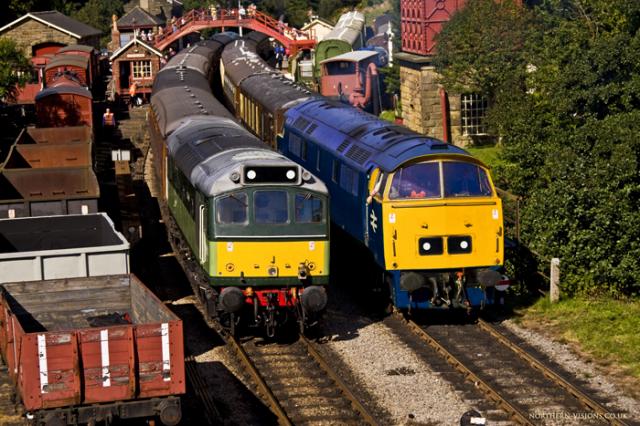
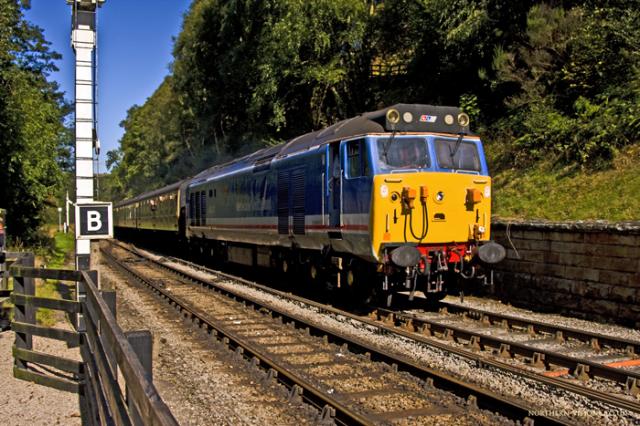
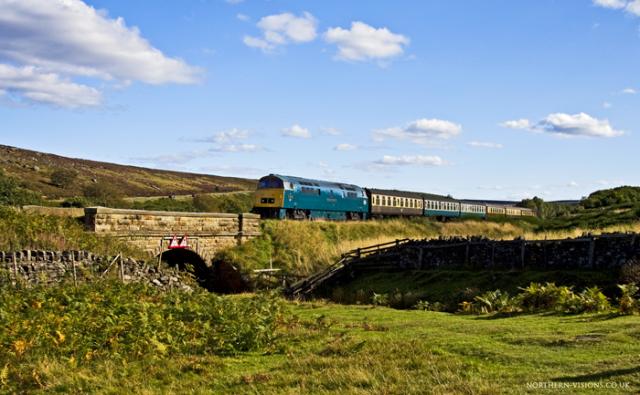

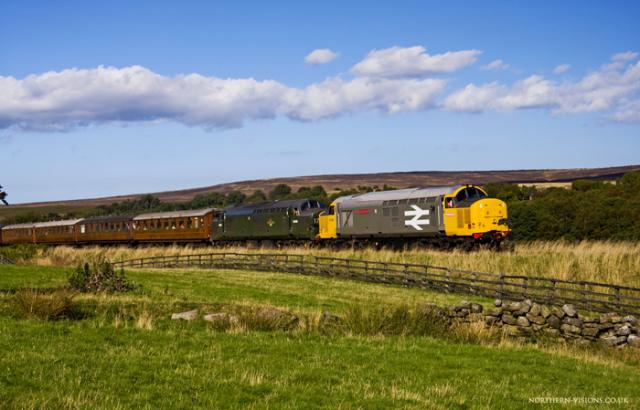
Definately an odd scene, a Network Southeast Engine on the North Yorkshire Moors.
This is one of my favourite spots on the Moors. A perfect view for taking pictures of trains. Luckily for once, there are not any sheep in the foreground of the shot. Don't leave your camera bag round for them to chew on!
2 class 37 Diesels pulling a rather small train for the power that they have. But a rare and interesting site non the less!
They are also known as English Electric Type 3 Locomotives.
They began life as part of the British Rail Modernisation plan. And were first constructed in the 1950's and 60's. And were a regular site all over the network. But especially running the Inter City Services from London to Scotland, and East Anglia. And in latter days a regular on the Freight runs all over the UK. They have the unenviable nickname as "Tractors", due to the sound they make.
There are many of these locos still in existence, due to there ongoing popularity. And numerous updates and rebuilds. So look forward to seeing more of them in the future.
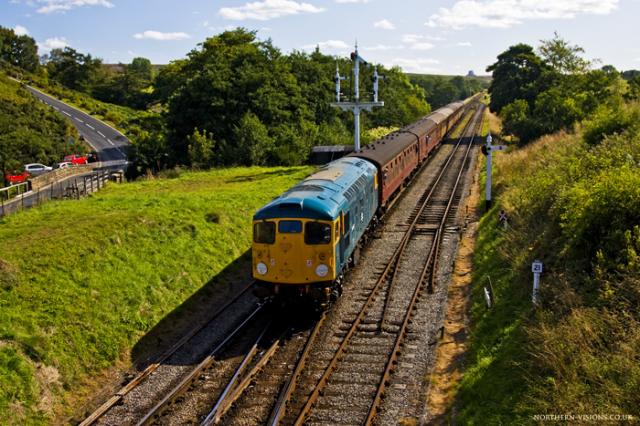
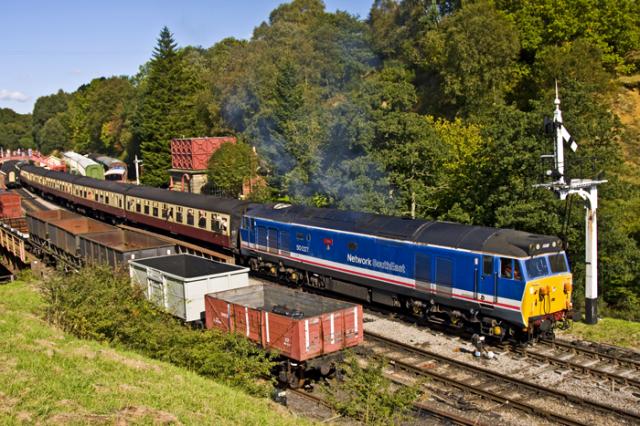
Our old friend the South Eastern moving away from Goathland Station.
Along with apparently, a rather unconvincing looking alien poking his head out of the door of Carriage number one behind the Engine!
I am not raving mad here, please look closer at the Preview of this photo and you will see yourself!
ps thanks lads, its amazing how many times this guy has been caught on camera....
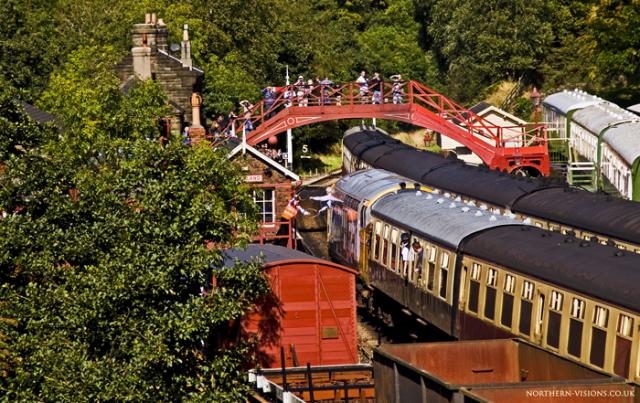
On Single lines like this one here. a token system was invented to prevent accidental collisions, IE 2 trains on the same line. The "One train working " system, was invented in Britain in the 19th Century, after incidents on the lines.
In theory, a single line has one token, and a train passing the signal box has to collect the "Token", and hand it over at the next signal box at the end of the single line. All the drivers are trained not to proceed along the line without the token. Thus preventing 2 trains colliding.
The token itself is a metal key, with a large loop of wire attached, and can be collected like this, by hand or by the use of a long wooden pole thus preventing the need to stop.
There was in later days a system where the driver only had to see the token, this was used on busy branch lines and speeded up operation.
But on the NYMR this system is still in operation, and there is no real need to change it.
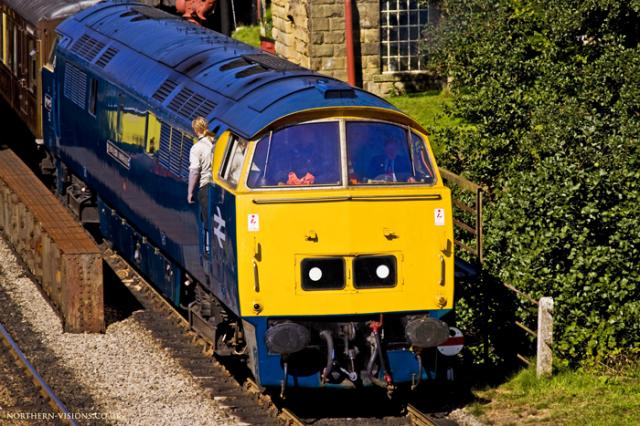
It was at this point when the train was trying to move out of the station, that things started to go a little wrong. There was alot of noise, sounding of horns ans smoke coming from the Black 5 that was on the end of the train, but no movement.
Unfortunately the normally reliable Black 5's brakes had stuck on. So after 4 blasts of the horn, alot of arm waving and walking up and down. They got the brakes fixed and away they went.
Arriving at Goathland.